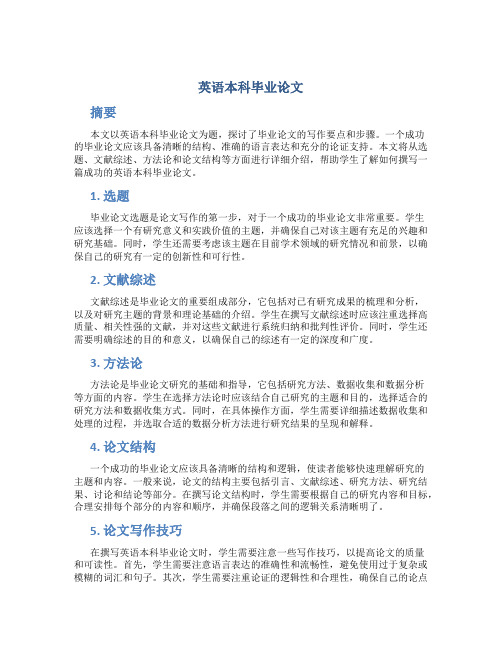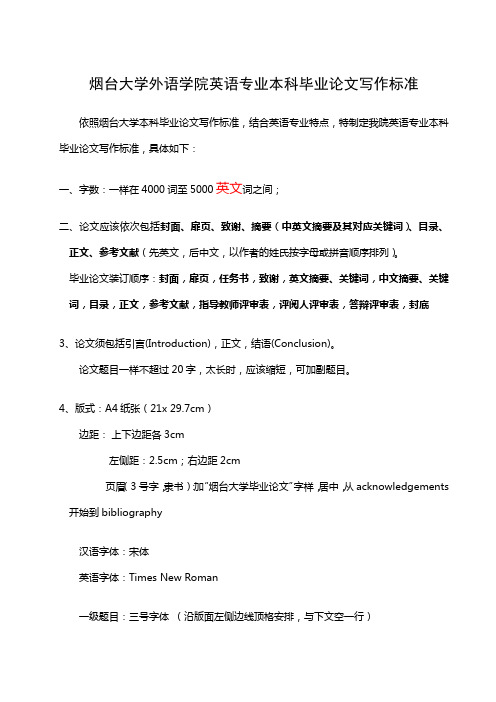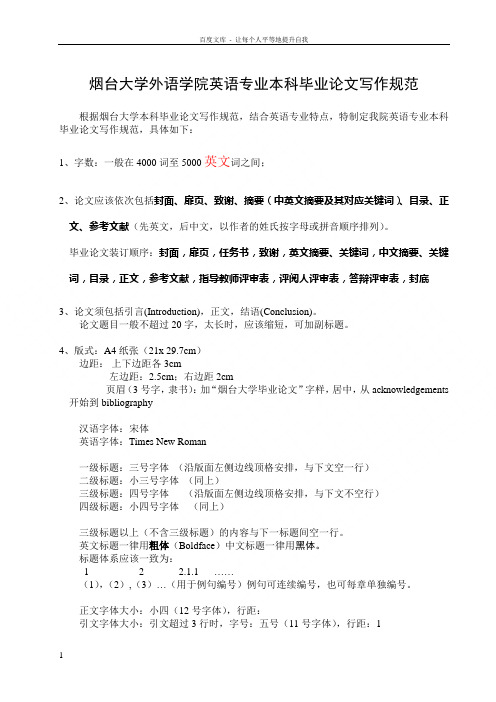英语系本科毕业论文细则
学校英语专业本科生学位论文格式规定

学校英语专业本科生学位论文格式规定
本科生毕业论文是实现人才培养目标的重要实践环节,对巩固、深化和升华学生所学理论知识,培养学生创新精神、独立工作能力、分析和解决问题能力起着重要作用。
做好本科生毕业论文知道工作,是培养学生科学精神、科学作风、良好的思想品德以及事业心和责任感等综合素质所不可或
缺的环节,毕业论文的质量直接影响到人才培养的质量。
为了统一学位论文的撰写、编辑、印刷,便于处理、储存、检索和交流,根据国家制定的有关标准和学校的有关规定,特对英语专业本科生学位论文的编写格式及打印提出如下具
体要求。
一、编写及打印要求
1、学位论文必须打印,不接受手写稿,同时交电子文本,一律用Microsoft Word 编辑。
交电子稿时,以学号和姓名为文件名建一个文件夹,学号在前,姓名在后。
论文只能为一个Word文档,也以同样方式命名。
2、论文必须用阿拉伯数字连续编排页码。
阿拉伯数字编排的页码由正文部分开始。
封面、任务书和封底不编入页码。
致谢、英汉语摘要、关键词和目录采用罗马数字编排页码,即致谢为第I页,汉语摘要及关键词为第II页,英语摘要、关键词为第III页;目录为第VI页。
正文页码从阿拉伯数字1开始直到论文结束。
页码居中。
3、页眉设置要求:居中,以小5号字宋体键入“平顶山学院本科毕业论文(设计)”。
页眉从正文页开始设置,到参考文献部分结束,包括参考文献部分。
封底不加页眉。
英语专业毕业设计内容及要求细则(教学法方向)

英语专业毕业设计内容细则(教学法方向) 一.影像资料内容1. 教学法的选择1)英语认知教学法2)英语功能教学法3)英语自然教学法4)英语交际教学法5)英语多元智能教学法 6)英语合作学习教学法 7)英语语言经验教学法 8)英语整体语言教学法 9)外语立体化教学法 10)情景语言教学法………2.实践教学要求1)需要有正规教室,学生,教材等。
2)在教学实践过程中,要体现对某个或某些教学法的应用、突破与创新。
3)要求教师语言规范,简洁生动,表达准确,阐述流畅。
4)着装整洁,仪表大方,教态亲切5)板书布局合理,书写流畅。
6)影像资料必须高度清晰,禁止用手机拍摄,授课时间为30分钟左右。
3.1)设计作品要求设计作品用纸:铜版纸封面230g,内页157g。
内页单面印刷6-10页或以上,采用全彩色方式,有图片部分,分辨率不少于500万像素,排版采用竖排版,左页边距2cm,采用活页装订。
2)影音制作要求光盘类型:CD视频文件格式:AVI、WMV、MPG等暴风影音支持的常见文件格式光盘上交要求:以班级为单位用光盘包装好,并注明班级,每张光盘上必须写明学号姓名专业+毕业设计名称命名,影音文件必须以学号姓名专业+毕业设计名称命名4. 影音的评分标准1)优秀A: 视频整体完整,色调鲜明,声音效果良好,时间不少于20分钟。
B: 实践设施特别完善,实践环境绝对真实。
C: 实习学生英语流利清晰,表达准确,阐述流畅并完全脱稿。
D. 着装整洁,仪表大方。
E. 在实践过程中,完美地体现了英语在不同领域的应用、突破与创新.2)良好A: 视频整体比较完整,色调比较鲜明,声音效果良好,时间不少于20分钟。
B: 实践设施比较完善,实践环境真实。
C: 实习学生英语比较流利清晰,表达比较准确,阐述流畅基本脱稿。
D. 着装整洁,仪表大方。
E. 在实践过程中,较好地体现了英语在不同领域的应用、突破与创新.3)中等A: 视频整体基本完整,色调基本鲜明,声音效果一般,时间不少于20分钟。
英语本科毕业论文

英语本科毕业论文摘要本文以英语本科毕业论文为题,探讨了毕业论文的写作要点和步骤。
一个成功的毕业论文应该具备清晰的结构、准确的语言表达和充分的论证支持。
本文将从选题、文献综述、方法论和论文结构等方面进行详细介绍,帮助学生了解如何撰写一篇成功的英语本科毕业论文。
1. 选题毕业论文选题是论文写作的第一步,对于一个成功的毕业论文非常重要。
学生应该选择一个有研究意义和实践价值的主题,并确保自己对该主题有充足的兴趣和研究基础。
同时,学生还需要考虑该主题在目前学术领域的研究情况和前景,以确保自己的研究有一定的创新性和可行性。
2. 文献综述文献综述是毕业论文的重要组成部分,它包括对已有研究成果的梳理和分析,以及对研究主题的背景和理论基础的介绍。
学生在撰写文献综述时应该注重选择高质量、相关性强的文献,并对这些文献进行系统归纳和批判性评价。
同时,学生还需要明确综述的目的和意义,以确保自己的综述有一定的深度和广度。
3. 方法论方法论是毕业论文研究的基础和指导,它包括研究方法、数据收集和数据分析等方面的内容。
学生在选择方法论时应该结合自己研究的主题和目的,选择适合的研究方法和数据收集方式。
同时,在具体操作方面,学生需要详细描述数据收集和处理的过程,并选取合适的数据分析方法进行研究结果的呈现和解释。
4. 论文结构一个成功的毕业论文应该具备清晰的结构和逻辑,使读者能够快速理解研究的主题和内容。
一般来说,论文的结构主要包括引言、文献综述、研究方法、研究结果、讨论和结论等部分。
在撰写论文结构时,学生需要根据自己的研究内容和目标,合理安排每个部分的内容和顺序,并确保段落之间的逻辑关系清晰明了。
5. 论文写作技巧在撰写英语本科毕业论文时,学生需要注意一些写作技巧,以提高论文的质量和可读性。
首先,学生需要注意语言表达的准确性和流畅性,避免使用过于复杂或模糊的词汇和句子。
其次,学生需要注重论证的逻辑性和合理性,确保自己的论点能够得到充分的论证和支持。
英语本科毕业论文格式标准

英语本科毕业论文格式标准————————————————————————————————作者:————————————————————————————————日期:1 总要求(General Requirements)1、用英文撰写、字数要求学士论文长度为4000 字,以能清楚、充分地论证某一论题或描写、解释某一发现为最低限度。
以上字数的统计范围仅限于论文正文,不包括论文摘要、目录、注释、参考书目和致谢。
2、格式要求论文一般由以下部分组成,并按此顺序排列:1. 英文标题页(English title page)2. 学位论文原创性声明(答辩时另发)3. 英文提要(Abstract)4. 中文提要(Chinese abstract)5. 目录(Contents)6. 正文(Text)7. 注释(Notes 非必须)8.参引文献(References,见附录)9. 致谢(Acknowledgements)(2)字体和字号:正文中大标题采用Times New Roman 小四号加粗(Introduction和Conclusion两词四号加粗,次标题以下采用Times New Roman 小四号加粗,正文采用Times New Roman 小四号字。
注意:大标题和次标题不得采用句子。
(3)行距:一律1.5 行距。
(4)页边距:2cm。
3、注释要求(一律采用“尾注Notes”,用序号,按出现顺序排列:名字在前,姓氏在后,其他与参考文献同。
)4、从论文的正文至致谢,均要求采用“页眉”(页眉右对齐)和“页码”(页码应居中)。
并在目录中标出。
封面(空两行;页边距为2cm)(Please write the English title of your thesis here)(Arial 一号加粗居中)(Please write the Chinese title of your thesis here)(宋体一号加粗居中)(空两行)Submitted by (Please write your name here) (Arial 三号加粗居中)Student number ( Please write your ID here ) (Arial 三号加粗居中)Supervised by (Please write the name of your tutor here) (Arial 三号加粗居中)(空两行)Foreign Languages College(Arial 小三号加粗居中)Jiangxi Normal University(Arial 小三号加粗居中)(Insert Month here) (Insert Year here) (Arial 小三号加粗居中)Title of the thesis(Times New Roman 三号粗体居中)(空一行)Abstract(Times New Roman 小四号加粗):正文(Times New Roman 小四号)………………………………………………………………………………………………………(空一行)Key words(Times New Roman 小四号加粗):正文(Times New Roman 小四号)…………………………………………………………………………………………摘要之后另起一行,给出论文的关键词3-5个(关键词要用分号“;” 分隔,结束不用句号,关键词不能超过5个)中文题目(宋体三号粗体居中)(空一行)摘要(宋体小四号加粗):正文(宋体小四号)………………………………………………………………………………………………………………………………………(空一行)关键词(宋体小四号加粗):正文(宋体小四号)………………………………………………………………………………………………(用分号“;”分隔,结束不用句号,)(空一行)提要格式要求:1、中文、英文摘要分页打印2、A4纸打印3、页边距:2cm4、行距:1.5倍行距Contents (Times New Roman 三号粗体居中)(空两行)Abstract (i)摘要 (ii)Introduction (1)1. ……………………………………………………………………………………1.1 ……………………………………………………………………………………1.2 …………………………………………………………………………………..2. ……………………………………………………………………………………..2.1 …………………………………………………………………………………..2.2 …………………………………………………………………………………..2.3 ……………………………………………………………………………………3. …………………………………………………………………………………….…Notes………………………………………………………………………………………….. Bibliography…………………………………………………………………………………. Acknowledgements……………………………………………………………………………目录格式要求:目录要自动生成!!所有标题都设为一级标题并顶格排列1、字体要求:Times New Roman 小四号粗体2、A4纸打印3、页边距:2cm4、行距:1.5倍行距5、论文内容排序:封面—声明—Abstract—摘要—Contents—正文—尾注—参考文献—致谢(空一行)从这一页开始Introduction (Times New Roman 四号加粗居中)(空一行)(5spaces) 正文……………………………………………………………………………………………………………………………………………………………………………(空一行)1 (Times New Roman小四号加粗)(5spaces) 正文……………………………………………………………………………………………………………………………………………………………………………1.1(Times New Roman小四号加粗)(5spaces) 正文……………………………………………………………………………………………………………………………………………………………………………1.1.1(Times New Roman小四号加粗)(5spaces) 正文………………………………………………………………………………………………………………………………………………………………………1.1.2(Times New Roman小四号加粗)(5spaces) 正文…………………………………………………………………………………………………………………………………………………………………………1.2(Times New Roman小四号加粗)(5spaces) 正文………………………………………………………………………………………………………………………………………………………………………1.2.1(Times New Roman小四号加粗)(5spaces) 正文………………………………………………………………………………………………………………………………………………………………………1.2.2(Times New Roman小四号加粗)(5spaces) 正文……………………………………………………………………………………………………………………………………………………………………2 (Times New Roman小四号加粗)(5spaces) 正文……………………………………………………………………………………………………………………………………………………………………………2.1(Times New Roman小四号加粗)(5spaces) 正文……………………………………………………………………………………………………………………………………………………………………………2.1.1(Times New Roman小四号加粗)(5spaces) 正文………………………………………………………………………………………………………………………………………………………………………2.1.2(Times New Roman小四号加粗)(5spaces) 正文…………………………………………………………………………………………………………………………………………………………………………2.2(Times New Roman小四号加粗)(5spaces) 正文………………………………………………………………………………………………………………………………………………………………………2.2.1(Times New Roman小四号加粗)(5spaces) 正文………………………………………………………………………………………………………………………………………………………………………2.2.2(Times New Roman小四号加粗)(5spaces) 正文……………………………………………………………………………………………………………………………………………………………………3 (Times New Roman小四号加粗)4 (Times New Roman小四号加粗)…Conclusion(Times New Roman 四号加粗居中)(5spaces) 正文………………………………………………………………………………………………………………………………………………………………………(另起一页)Notes(Times New Roman 四号加粗居中)正文(Times New Roman 小四号)[1]作者,书名(英文书名格式为Times New Roman小四号斜体;中文书名格式为《宋体小四号》),出版社,出版时间:页码.(有一实心点作为句号)[2]如出处同上一个注释,则标为ibid(空一格)(页码).[3]……(另起一页)Bibliography(Times New Roman 四号加粗居中)英文参考书目(按首写字母顺序排列)网络参考资料中文参考书目(按汉语拼音顺序排列)参考文献写作规范1.说明(1)文献目录应另页书写,外文文献排前,中文文献排后。
英语专业毕业论文撰写基本要求及格式规范

湖北师范学院外国语学院英语专业本科毕业论文撰写基本要求及格式规范本格式规范在参照《湖北师范学院本科毕业论文(设计)工作实施办法》的基础上、结合英语研究论文撰写的特点而制定,适用于湖北师范学院外国语学院英语专业全日制本科毕业论文的撰写。
一、毕业论文(设计)打印页面设置1、页面设置:16开版面,单页打印。
2、页边距及行间距:上2。
5厘米,左2。
5厘米,下2厘米,右2厘米,左侧装订,页眉1。
5,页脚1。
75。
除一二级标题及特别注明外,行间距统一为1.25。
3、页眉:目录、摘要、正文、参考文献每页页眉居中标注“湖北师范学院外国语学院**届英语系毕业论文(设计)”字样,五号宋体居中打印。
4、字体和字号:按相应部分的要求分别设置.5.页码编号:从正文起每页页脚加注页码(宋体五号居中),封面页、目录页、英、汉摘要页不编页码。
二、毕业论文(设计)构件及格式要求外国语学院本科生毕业论文应由以下几个部分构成:1、封面页:独立一页(具体格式见附件1)(1)学号:按学生成绩册的学号填写.(2)编号:按毕业年份+外国语学院编号+班级编号+学号的最后两位共十位填写。
如:2008040122。
(3)研究类型:按基础研究、应用研究、综合研究等类型填写.(4)分类号:按中国图书分类号填写。
(5)封面中论文标题栏部分为Times New Roman三号。
封面顶部项目为中文宋体小四号,其余部分用中文宋体三号填写。
2、毕业论文诚信承诺书:本科毕业论文诚信承诺书见外国语学院网页提供的附件,按照要求格式填写,该页独立成一页,附于封面页后的第一页。
3、目录页(英文):独立一页,(具体格式见附件2)。
(1)除“Contents”一词用Times New Roman三号加粗外,其他统一用Times New Roman小四号。
(2)本页内的论文目录及页码部分由正文标题内容自动生成。
请使用word的目录生成功能,具体操作为:分别选择正文中标题文字,用主菜单“格式”中的“样式与格式”功能定义正文中的标题级别,定义完毕后,再点击主菜单中“插入"→“引用”→“索引和目录”即可自动生成目录。
本科英语系毕业论文框架

本科英语系毕业论文框架Title: An Analysis of the Impact of English Major Programs on Undergraduate StudentsAbstract:This paper aims to investigate the impact of English major programs on undergraduate students. It examines the benefits of English major programs, including language proficiency, cultural awareness, and critical thinking skills. Additionally, it explores the challenges faced by English major students and provides recommendations for improvements.1. Introduction- Background: The popularity of English major programs in undergraduate education- Significance of the study: The importance of studying the impact of English major programs on undergraduate students- Research question: How do English major programs influence undergraduate students?2. Benefits of English Major Programs- Language proficiency- Enhancing reading and writing skills- Developing effective communication skills- Cultural awareness- Exposure to different cultures and perspectives- Promoting intercultural understanding and tolerance- Critical thinking skills- Analyzing and interpreting literary texts- Developing the ability to think critically and solve problems effectively3. Challenges faced by English Major Students- Language barrier- Difficulties in understanding and producing academic English- Limited access to language resources- Job market competitiveness- High expectations for English major graduates- Limited job opportunities in the field- Curriculum design and teaching methods- Insufficient practical application of language skills- Heavy reliance on theoretical knowledge4. Recommendations for Improvement- Enhancing language support- Offering language courses specifically tailored for English major students- Providing access to language resources and tutoring services- Collaboration with industries- Establishing partnerships with companies to create internship opportunities- Incorporating real-world projects into the curriculum- Curriculum revision- Balancing theoretical knowledge and practical application- Introducing more interactive and experiential learning methods- Integrating technology and multimedia resources5. Conclusion- Summary of findings: The benefits and challenges of English major programs- Implications for undergraduate education: The importance of continuously improving English major programs- Limitations of the study: The need for further research in specific sub-areas- Final remarks: The overall impact of English major programs on undergraduate students and the potential for future development。
论文打印规则

请注意:1.一篇英语专业本科毕业论文,全篇的文字,字体、字号必须统一(一般用TimesNew Roma, 五号字)。
2.论文的封面,汉语与英文的,同样格式,各做一页。
不可混在一起。
3.Contents 必须单独一页;必须两端对齐。
4.Abstract, 中文一页,英文一页,不可混在同一页。
Key Words 一般与Abstract正文之间有几行的间隔。
不要把作品名、作品中人物的名字列为Key word。
5.论文的正文,一定要“左对齐”;但不一定要求“两端对齐”(右侧可不对齐)。
6.文中的标题,试情况而定,可以比正文字号略大,也可以“加粗”,但必须与正文字体相同。
7. 根据英文书写规则,文中的每一段,可以第一行左缩进(四个字母空格),也可左对齐。
但是,若左对齐,请在段与段之间空一行。
若每段第一行左缩进,段与段之间则可不空行。
8. 英文打字的规矩:每个逗号后面,空一格,再打下一个字;在每个句号后面,空一格,再打下一句话。
9. 英文行文中换行的规矩:a. 换行的最小单位是一个章节;b. 单个不成章节的字母,不可以换行。
c. 人名、地名、专用名词,不可拆分换行。
d. 标题中若有多字组成的人名、地名等,尽量调整到同一行中, 尽量避免中间换行。
e. 行文中,不可将“所属格”(’s)换至下一行。
f. 标点符号(除成对使用的之外)不可换行。
10. 文章中出现书名、文章标题,必须用斜体字或者引号标示。
11. 论文中,若有引文,成段的引文部分,请“左缩进”(第一行缩进八个空格,其它部分缩进四个空格),并将引文部分整体使用斜体字。
引文的最后,用“上标”数字,或者用“方括号+数字”表示注释。
但是,上标数字中可以出现在一行的最左侧。
不成段落的,单句的,或短语的引文,可用引号;引文部分不用斜体字,但需要“上标数字”或“括号数字”。
12.提交论文之前,请对自己的文章做认真的检查;必须要做的一点:改正电脑自动显示出的打印中出现的错字。
本科生英语专业毕业论文格式

本科生英语专业毕业论文格式1. 封面:汉语,由教务处统一格式和印制,各学院制作。
题目用汉语。
2. 封二:学生对论文写作内容的声明,文责自负,由教务处统一格式和印制,各学院制作,学生本人填写。
3. 封三:指导教师评定成绩、评语页,统一印制。
4. 封底:()记录、成绩及论文总评成绩。
教务处统一格式,各学院制作。
5. 英文论文封面(English Title Page):由学生按照统一的格式制作。
6. 英文摘要及关键词和中文摘要及关键词(Abstract and Key Words):论文要有200-300字的摘要,能客观反映主要内容信息,具有独立性和包含性。
反映论文主题概念的词或词组,一般每篇3~8个。
单独一页。
7. 提纲和论文陈述(Outline and Thesis Statement):另起一页开始提纲。
8. 正文局部(The Text of the Paper):另起一页开始正文。
学年论文正文字数应在3000字以上6000字以内,毕业论文正文字数应不少于6000字。
文内夹注格式参照教材《英语学术论文写作》和“论文模板”。
1. Introduction2. Body3. Conclusion9. 尾注(Notes):另起一页开始尾注。
10. 引用文献(Works Cited):英献在前,汉献在后,另起一页附引用文献。
引用文献格式参照教材《英语学术论文写作》和“论文模板”。
11. 全篇论文格式参见本文档中的“论文模板”。
12. “论文模板”中未详尽例举的格式,请参阅教材《英语学术论文写作》。
13. 论文要求一律用A4纸张单面打印,统一按word格式A4纸(“页面设置”按word默认值)编排、打印。
14. 需要上交存档的论文一式两份,按封面、封二、、指导检查情况记录表、正文、指导教师评分表、辩论及成绩评定记录表依次装订。
辩论时提交给评议教师提交论文的分数另行决定。
烟台大学外语学院英语专业本科毕业论文写作标准

烟台大学外语学院英语专业本科毕业论文写作标准依照烟台大学本科毕业论文写作标准,结合英语专业特点,特制定我院英语专业本科毕业论文写作标准,具体如下:一、字数:一样在4000词至5000英文词之间;二、论文应该依次包括封面、扉页、致谢、摘要(中英文摘要及其对应关键词)、目录、正文、参考文献(先英文,后中文,以作者的姓氏按字母或拼音顺序排列)。
毕业论文装订顺序:封面,扉页,任务书,致谢,英文摘要、关键词,中文摘要、关键词,目录,正文,参考文献,指导教师评审表,评阅人评审表,答辩评审表,封底3、论文须包括引言(Introduction),正文,结语(Conclusion)。
论文题目一样不超过20字,太长时,应该缩短,可加副题目。
4、版式:A4纸张(21x 29.7cm)边距:上下边距各3cm左侧距:2.5cm;右边距2cm页眉(3号字,隶书):加“烟台大学毕业论文”字样,居中,从acknowledgements 开始到bibliography汉语字体:宋体英语字体:Times New Roman一级题目:三号字体(沿版面左侧边线顶格安排,与下文空一行)二级题目:小三号字体(同上)三级题目:四号字体(沿版面左侧边线顶格安排,与下文不空行)四级题目:小四号字体(同上)三级题目以上(不含三级题目)的内容与下一题目间空一行。
英文题目一概用粗体(Boldface)中文题目一概用黑体。
题目体系应该一致为:1 2 2.1.1 ……(1),(2),(3)…(用于例句编号)例句可持续编号,也可每章单独编号。
正文字体大小:小四(12号字体),行距:引文字体大小:引文超过3行时,字号:五号(11号字体),行距:1每一段开头缩进四个英文字符的位置,段与段之间不空行。
5、题目页、致谢、摘要、每章、参考文献都要另起页。
6、参考文献转行时第二行需空格:英文空4个字符;汉语空两个汉字。
7. 页码的标注:内封、致谢不标页码;摘要、目录标页码,用小罗马字,居中;其余部份用阿拉伯数字标注,居中。
英语本科毕业论文字数

英语本科毕业论文字数英语本科毕业论文字数作为一名英语本科毕业生,我深知毕业论文的重要性。
在大学四年的学习中,我们通过各种课程和实践活动积累了大量的知识和技能,而毕业论文是对我们所学知识的综合运用和展示。
在撰写毕业论文之前,我们需要确定一个合适的字数范围。
英语本科毕业论文字数的要求通常是在3000到10000字之间。
这个范围给了我们足够的空间来展开我们的论述,同时也不至于过于冗长。
当然,具体的字数要求可能会因学校和专业的不同而有所差异,所以在写作之前,我们需要仔细阅读学校和专业的毕业论文指南,了解具体的要求。
在确定字数范围之后,我们需要合理安排论文的结构和内容。
一篇毕业论文通常包括引言、文献综述、研究方法、研究结果和讨论、结论等部分。
在每个部分中,我们都需要清晰地陈述问题、目的和方法,并逐步展开论述。
在每个部分的撰写过程中,我们可以根据需要进行适当的分段,以提高文章的可读性。
除了结构的安排,我们还需要注意语言的表达。
毕业论文是一篇学术性的文章,所以我们需要使用准确、规范的英语表达我们的观点和研究结果。
在写作过程中,我们可以参考相关的学术论文和专业书籍,以提高自己的写作水平。
同时,我们还可以向导师和同学请教,以获得更多的反馈和建议。
在写作过程中,我们还需要注意论文的逻辑性和连贯性。
我们的观点和论证需要有条理地展开,以便读者能够清晰地理解我们的研究思路和结论。
我们可以使用适当的连接词和过渡句来帮助读者理解我们的观点之间的关系,并使整篇论文更加流畅。
此外,我们还需要注意论文的参考文献的引用。
在写作过程中,我们需要准确地引用他人的观点和研究成果,以避免抄袭和知识产权的问题。
我们可以使用标准的引用格式,如APA、MLA等,以确保我们的引用符合学术规范。
总之,英语本科毕业论文字数的确定和论文的撰写是一个复杂而关键的过程。
我们需要合理安排论文的结构和内容,注意语言的表达,保持论文的逻辑性和连贯性,并准确引用参考文献。
本科英语专业论文写作要求与规范

本科英语专业论文写作要求与规范1总体要求错误!未定义书签。
2论文撰写的时间安排错误!未定义书签。
3 论文打印错误!未定义书签。
4论文定稿的装订内容、顺序及附件。
错误!未定义书签。
5封面错误!未定义书签。
6诚信承诺书错误!未定义书签。
7中英文摘要和关键词错误!未定义书签。
8目录错误!未定义书签。
9 论文主体错误!未定义书签。
10论文内引文及脚注错误!未定义书签。
11参考文献错误!未定义书签。
1总体要求一、毕业论文是考察学生综合能力、评估学业成绩的一个重要方式。
毕业论文应用英语撰写,由作者在导师的指导下独立完成,论文应当格式正确,文字通顺、结构清晰、内容充实、论证严密,有一定的独立见解,主体部分长度达到5000——6000个英文单词,二、学生与指导教师应加强论文写作交流。
指导教师应定时检查学生的论文写作情况,给予指导;学生应与指导教师加强联系,积极、主动地解决写作中出现的问题,按时完成毕业论文。
三、为便于修改和评阅,论文定稿应在毕业答辩前两周完成,并向学院提交2份为论文。
四、为及时存档,答辩通过后,学生应根据答辩教师意见,再次修改论文,然后加装学校统一封皮,上交学院。
电子文稿上交指导老师。
五、有列情形之一者,不予答辩。
(一)未按规定时间提交论文及论文附件。
(二)论文存在严重问题未修改。
(三)指导教师或评阅教师认为未达到本科毕业论文水平。
(四)论文内容有40%以上重复其它论文。
2论文撰写的时间安排一、选题:10月30日前,完成编制毕业论文工作计划、教师拟题、学生选题、落实指导教师等工作。
二、开题:11月1日~11月10日,指导教师指导学生查阅资料,开始撰写文献综述、开题报告;11月15日~12月10日,进行开题报告、选题检查,并把学院的毕业论文选题汇总后上报教务处备案12月11日~1月22日学生完成开题报告、文献综述,经指导教师审阅通过后开始毕业论文写作三、撰写:1月23日~3月5日完成论文一稿3月6日~4月6日完成论文二稿4月7日~4月30日完成三稿5月1日~5月10日定稿四、答辩与成绩评定阶段:5月15日前指导教师、评阅教师完成成绩评定5月20日前上报毕业论文答辩日程安排,公示答辩时间5月21日~5月25日组织毕业论文答辩,完成成绩综合评定6月5日之前,学生根据答辩意见修改毕业论文并提交学院,同时提交电子文档。
外国语学院英语专业本科生毕业论文撰写规范

外国语学院英语专业本科生毕业论文撰写标准一、毕业论文格式〔一〕总体要求1.毕业论文一律用英语撰写。
2.毕业论文格式须符合本标准的根本要求,并按照本标准排版、打印。
〔二〕封面按照学院统一规定的封面款式打印。
须在中文标题上方加上英文标题。
〔三〕标题1.题目应该简短、明确,具有概括性。
通过题目,能大致理解论文内容、专业特点和学科范畴。
2.字数一般不宜超过20个字,必要时可以加副标题。
3.论文题目置于正文之前,格式为Times New Roman字体三号,加粗,居中,上、下各空一行。
〔四〕英文摘要及关键词1.摘要应该将毕业论文的内容要点简短明了地表达出来,应该包含论文中的根本信息,表达其核心思想。
2.突出毕业论文中具有创新性的成果和新见解的局部,不用展开论证或说明。
3.以客观陈述为主,不用进展主观评价;以第三人称对文中观点进展概括和提炼,防止以“作者指出〞等类词语表述。
4.独立成文,选词用语防止与正文内容特别是前言(绪论)和结论局部雷同。
5.语言力求精练,字数以200—300字为宜,控制在300字以内。
6.关键词以3—5个名词为宜,为论文中最重要、出现频率最高、能表达论文主题的词。
7.居中打印“ABSTRACT〞〔 Times New Roman字体四号加粗〕,空一行打印英文摘要内容〔Times New Roman字体四号〕,摘要内容每段开头留四个字符空格。
8.摘要内容后下空一行居中打印“KEY WORDS〞〔 Times New Roman字体四号加粗〕,再空一行打印关键词〔Times New Roman字体四号〕,每一关键词之间用分号分开,最后一个关键词后不打标点符号。
9.页面上边距:30mm;下边距:25mm;左边距:30mm;右边距:20mm。
10.英文摘要与关键词单独为一页。
〔五〕中文摘要及关键词1.中文摘要内容应与英文摘要根本相对应,语句通顺,文字流畅。
2.中文关键词与英文关键词应根本对应。
烟台大学外语学院英语专业本科毕业论文写作规范

烟台大学外语学院英语专业本科毕业论文写作规范根据烟台大学本科毕业论文写作规范,结合英语专业特点,特制定我院英语专业本科毕业论文写作规范,具体如下:1、字数:一般在4000词至5000英文词之间;2、论文应该依次包括封面、扉页、致谢、摘要(中英文摘要及其对应关键词)、目录、正文、参考文献(先英文,后中文,以作者的姓氏按字母或拼音顺序排列)。
毕业论文装订顺序:封面,扉页,任务书,致谢,英文摘要、关键词,中文摘要、关键词,目录,正文,参考文献,指导教师评审表,评阅人评审表,答辩评审表,封底3、论文须包括引言(Introduction),正文,结语(Conclusion)。
论文题目一般不超过20字,太长时,应该缩短,可加副标题。
4、版式:A4纸张(21x 29.7cm)边距:上下边距各3cm左边距:2.5cm;右边距2cm页眉(3号字,隶书):加“烟台大学毕业论文”字样,居中,从acknowledgements 开始到bibliography汉语字体:宋体英语字体:Times New Roman一级标题:三号字体(沿版面左侧边线顶格安排,与下文空一行)二级标题:小三号字体(同上)三级标题:四号字体(沿版面左侧边线顶格安排,与下文不空行)四级标题:小四号字体(同上)三级标题以上(不含三级标题)的内容与下一标题间空一行。
英文标题一律用粗体(Boldface)中文标题一律用黑体。
标题体系应该一致为:1 2 2.1.1 ……(1),(2),(3)…(用于例句编号)例句可连续编号,也可每章单独编号。
正文字体大小:小四(12号字体),行距:引文字体大小:引文超过3行时,字号:五号(11号字体),行距:1每一段开头缩进四个英文字符的位置,段与段之间不空行。
5、题目页、致谢、摘要、每章、参考文献都要另起页。
6、参考文献转行时第二行需空格:英文空4个字符;汉语空两个汉字。
7. 页码的标注:内封、致谢不标页码;摘要、目录标页码,用小罗马字,居中;其余部分用阿拉伯数字标注,居中。
外语系英语专业本科生毕业论文撰写规范

外语系英语专业本科生毕业论文撰写规范(试行)毕业论文是高等教育人才培养方案中一个重要的实践教学环节,是高等学校实现本科培养目标要求的重要阶段。
为保证外语系毕业论文质量,特制定本规范。
1.内容要求1.1 题名 (Title)论文题名应该是以最恰当、最简明的词语反映论文中最重要的特定内容的逻辑组合。
论文题名字数要适当,外文题名一般不宜超过10个实词;中文题名一般不宜超过20字,必要时可增加副标题。
1.2 摘要和关键词1.2.1 摘要(Abstract)论文摘要是论文的内容不加注释和评论的简短陈述,一般应说明毕业论文的目的、主要成果和结论性意见,文字要精炼。
中文摘要在前,英文摘要在后。
英文摘要200-300字。
1.2.2 关键词(Key Words)关键词是供检索用的主题词条,应是能覆盖论文主要内容的单词或术语。
关键词一般为6-8个,以显著的字符另起一行,排在摘要的左下方。
1.3英文目录(Contents)目录一级标题使用罗马数字,二级标题使用英文大写字母,目录显示到二级标题(A,B,C)即可,按照数字、字母顺序编写,要求层次清晰,目录中的标题要与正文中的标题一致。
目录中应包括中文摘要、英文摘要(相应页码用罗马数字标注)、引言、主体、结论、参考文献、致谢、附录(相应页码用阿拉伯数字标注)。
1.4 正文 (Text)正文是毕业论文的核心部分,占主要篇幅。
一般包括引言、主体及结论等部分。
引言作为第1章,是毕业论文正文的开端,引言部分不得少于500字。
引言应包括:毕业论文选题的背景、目的及意义;国内外研究状况和相关领域中已有的研究成果;对选题的认识,思考等。
应注意引言不能与摘要雷同,不要成为摘要的注释。
1.4.2 主体(Main body)论文主体是毕业论文的主要部分,应结构合理、层次清晰、重点突出、文字简练通顺。
论文主体至少3部分,论文主体的内容应包括:对研究问题的论述、分析、比较、研究等等。
1.4.3 结论(Conclusion)结论单独作为一章编写,但不加章节号。
- 1、下载文档前请自行甄别文档内容的完整性,平台不提供额外的编辑、内容补充、找答案等附加服务。
- 2、"仅部分预览"的文档,不可在线预览部分如存在完整性等问题,可反馈申请退款(可完整预览的文档不适用该条件!)。
- 3、如文档侵犯您的权益,请联系客服反馈,我们会尽快为您处理(人工客服工作时间:9:00-18:30)。
